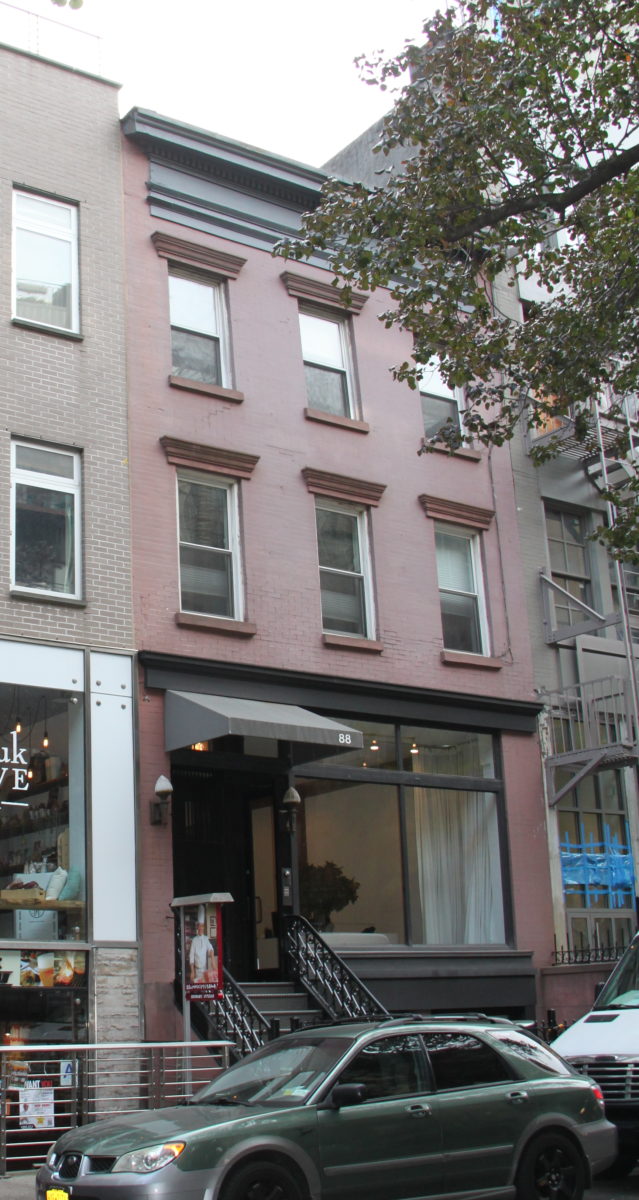- Home
- East Village Block Finder
- Guided Tours
- African American History
- Astor Tenements
- CBJ Snyder Schools
- Churches
- Dry Dock District Tour
- Historic East 10th Street
- Individual Landmarks
- Kleindeutschland
- LGBTQ Sites
- Little Ukraine
- Loisaida Tour
- Music Venues
- Off-Off Broadway Theatres
- Places that Matter
- Punk Rock
- Squats of the East Village
- Synagogues
- Yiddish Rialto
- Glossary
88 East 10th Street | Block : 555 | Lot #123
- Building Date : 1845
- Original Use : Residential
- Original Owner : Peter Stuyvesant/Moses E. Arment
- Original Architect : Unknown
Description & Building Alterations
This row house was built between 1844 and 1845 as a private residence. In 1844 it was owned by Peter Stuyvesant, and then in 1845 it was sold to Moses E. Arment. In 1903, an extension was added onto the rear of the building, and occupancy included stores, offices, and one family on the third floor. Forty-three years later, in 1946, the cellar was used as storage, the basement housed offices, the first floor was used by a restaurant and a printer, and the second and third floors were designated as manufacturing areas.
“One of the most notable sculptors of the twentieth century” according to the National Women’s History Museum, the Harlem Renaissance artist, educator, and self-described “people’s sculptor” Selma Hortense Burke lived and worked at 88 East 10th Street from 1944 until at least 1949 according to New York City directories. While here, Burke completed her most renowned work: a 2 ½ by 3 ½ foot relief plaque commemorating President Franklin D. Roosevelt, which was used as a model for his image on the U.S. dime coin. Burke is celebrated for her lifelong commitment to the art of sculpture and to art education, for her highly regarded portrayals of towering African American figures such as Martin Luther King Jr., Booker T. Washington, and Mary Macleod Bethune, for her significance in the Harlem Renaissance, for her unabashed drawing upon African models for her art, and for achieving success as a Black woman sculptor at a time when few female or Black artists, and even fewer Black female artists, were able to achieve any success or recognition in the United States.
A Certificate of Occupancy reveals that in 1953 the cellar and basement were used for storage, the first floor was an office, the second floor was a tailor, and the third floor contained an art studio. The art studio (and living space on the same floor) belonged to Willem de Kooning, a Dutch American abstract expressionist and action painter who was part of a group of artists that came to be known as the New York School, from 1951 until 1963. De Kooning completed “Woman I” upon his move to this studio, and the Highway paintings were his final works completed here. He also lived and worked here when he began to exhibit with Sidney Janis, when he developed a drinking problem when he had a relationship with Joan Ward, and when his only child was born. Across the hall from de Kooning was the studio of artist Esteban Vicente.
Hans Hoffman moved into the studio space after de Kooning. Other painters in this group included Jackson Pollock, Franz Kline, Esteban Vicente, Arshile Gorky, Mark Rothko, Hans Hofmann, Adolph Gottlieb, Robert Motherwell, Philip Guston, and Clyfford Still. De Kooning, one of the most influential artists of the twentieth century, lived and worked for the seven most critical years of his career at 88 East 10th Street, between Third and Fourth Avenues, when that block was the center of the New York art world. The facade of the building is intact from de Kooning’s Time. The garden and parlor floor has been converted to commercial usage, but the stoop retains its original iron railings. The second and third floors are intact.
Block : 555 / Lot : 123 / Building Date : 1845 / Original Owner : Peter Stuyvesant/Moses E. Arment / Original Use : Residential / Original Architect : Unknown


Do you know this building? Please share your own stories or photos of this building here!